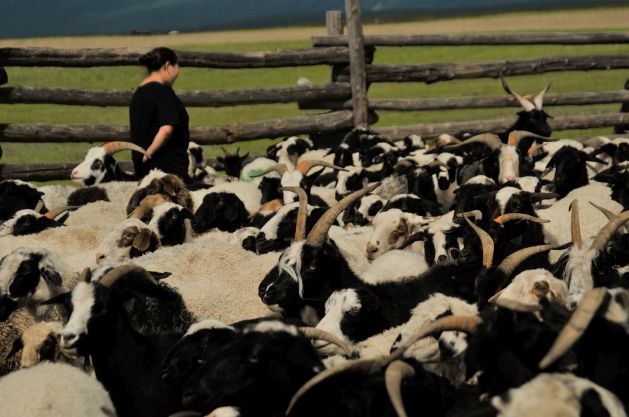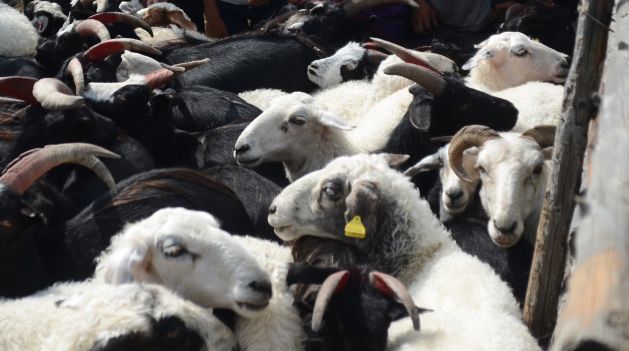[ad_1]

BAT ULZII DISTRICT, Mongolia, Jul 19 (IPS) – “My son went after his cow. He’ll come quickly. Our work begins as quickly because the solar rises — milking the cows, herding the sheep, rearing the calves, and on it goes. There may be nothing tougher than shedding cows and calves on scorching summer time days,” says herder D. Chimiddulam, standing in inexperienced grass on one facet of a tall picket fence, taking a look at dozens of black and white sheep and goats within the enclosure.
Chimiddulam was born and has been elevating livestock for greater than 40 years in Bat-Ulzii district, 452 km southwest of Mongolia’s capital metropolis Ulaanbaatar. Throughout these many years she has spent many hours monitoring down her wandering animals, however because of a brand new digital record-keeping undertaking she will be able to now discover her livestock a lot quicker.
Bat-Ulzii is certainly one of 4 districts in Uvurkhangai Province to host the web-based Animal Identification and Registration system (AIRS), managed by the Ministry of Meals, Agriculture and Mild Trade and the UN Meals and Agriculture Group (FAO).
Almost 200,000 animals had been fitted with an ear tag that has a novel quantity and barcode. Every code is entered in a database. The outcome: when it’s time to promote, find or just study the background of a selected animal, the knowledge is obtainable on-line.
“Over 200 households have 7,200 cows and greater than 56,000 sheep and goats tagged,” says L. Batchuluun, former head of the municipal state workplace, who was answerable for the undertaking in Bat-Ulzii.
Livestock are registered with a 12-digit code. The primary two digits symbolize the province, the following two numbers are for the district, the following two symbolize the village quantity, and the remaining six digits are the non-public variety of the animal. Utilizing a smartphone software, officers can register the knowledge on the bottom, eliminating tedious paperwork.
“By tagging livestock, their origin turns into clear, enabling us to watch whether or not the merchandise that meet high quality requirements have reached the palms of the buyer,” Batchuluun provides in an interview. That may make the meals provide safer he says.
In 2021, 188,500 households in rural areas raised a complete of 67.3 million livestock in Mongolia, making up an vital 38.4 % of the GDP of provinces and native areas. The animals additionally provide greater than half one million tonnes of meat for the home market.
Not solely are livestock a serious supply of meals, farmers additionally earn revenue by promoting by-products together with dairy merchandise, cashmere, and wool.
In response to Chimiddulam, AIRS has had many optimistic impacts. For instance, as a result of most livestock are registered within the system, disputes over possession could be prevented. And if animals from completely different herds get blended collectively, they are often rapidly recognized and separated. The system additionally discourages theft.
As a result of animals could be recognized by quantity, herders can depart messages and talk with one another when their livestock disappear or wander distant to graze. For example, a household six km from Chimiddulam’s home acknowledged her cows by their tags and referred to as her to report the information.
Additionally, says the herder, she would beforehand must drive 20-30 km to the district centre to have the origin of the animals verified. If a veterinarian was not accessible, she must return. In the meantime, doubts in regards to the origin of the animal may come up. In the present day, that proof of authenticity is obtainable on the click on of a mouse, and even through a smartphone with a barcode reader.
“Now we have made about 300 small earrings… by tagging the cattle and having a registration database, it’s not obligatory to acquire a certificates of origin for livestock, which makes our work simpler,” she provides.
The system additionally allows officers to behave rapidly in case of a illness outbreak and can enhance breeding programmes, in accordance with FAO’s Mongolia Nation Workplace.
 56,000 small animals in Bat-Ulzii had been fitted with an ear tag after being registered in AIRS. Credit score: Namuunbolor Tumur-Ochir/IPS
56,000 small animals in Bat-Ulzii had been fitted with an ear tag after being registered in AIRS. Credit score: Namuunbolor Tumur-Ochir/IPS
In the long run, herders may also profit from a possible improve in worth for livestock merchandise which are traceable, insurance coverage and tax advantages, and documentation they will use for banking functions. The brand new system may also help the federal government’s precedence to develop export markets for meat, provides FAO.
Section 2 of AIRS will embody an software designed for herders, which might enable them to maintain observe on their smartphone of the animals they’ve registered, purchased and bought.
Bat-Ulzii soum is a vital vacationer vacation spot, well-known for its pure magnificence. Ankle-high grass and vibrant flowers are rising, and vacationer numbers appear to be rebounding after gradual years throughout the top of the Covid-19 pandemic. This makes the herders smile, as they earn further revenue by offering their horses and yaks as transportation for vacationers.
Some farmers have taken benefit of digitalization by becoming their horses with microchips in a programme associated to AIRS.
In response to L. Batchuluun, “greater than 2,200 horses have been put in with locators. By permitting us to know the place our herds are it is going to be an important enchancment within the lives of herders. It can additionally assist to stop livestock theft.”
The Ministry of Meals, Agriculture and Mild Trade says it’s making ready to develop AIRS all through the nation.
© Inter Press Service (2022) — All Rights ReservedAuthentic supply: Inter Press Service
[ad_2]
Source link




